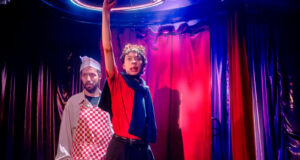A muddled, static story greatly enlivened by powerful performances in a stunning locationSummary
Rating
Good
HG Wells wrote The Time Machine, his first novel, in 1895. The following year he joined the London Library, so it’s fitting that this is the location for the latest interpretation of his acerbic prediction of future civilisation.
You’re met at the entrance by one of four Time Travellers, depending on your allotted time slot – the audience is admitted in small batches, due to the confined spaces. My Time Traveller was played with enthusiastic verve by Clare Humphrey, Mad Maxed up to the full in multiple layers of sand and moss-coloured clothing, and fingerless gloves. Nothing says post-apocalyptic decline quite like fingerless gloves.
She’s come from the past, or rather an alternative version of the past, in which time travel was invented as a wartime weapon. The Time Machine, a battered suitcase on which you chalk the date you want to visit, then takes you to your destination as your Time Traveller whisks you through multiple locations of the library.
The London Library is an astonishing venue, a labyrinthine assortment of reading rooms, some with computer screens, others with leather armchairs and galleried bookshelves. One scene takes place in the book stacks, four storeys high, with iron gratings for floors that allow you to see through to the basement below. They were apparently designed this way for ventilation; it’s rather doubtful whether their fire-retardant property would be allowed today. Ashley Bale’s lighting design makes each room evocative and mysterious, with Matt Eaton’s subtle sound design adding plenty of depth.
Along the way we meet Computer, first on the screens and then in person. He’s played to perfection by Graeme Rose, in a three-piece suit with a glittery face and gold gloves. Petulant and argumentative, he’s a walking Wikipedia who moves with jittery mechanical precision: “Tell Alexa I love her” is his parting remark.
The original novel tells the story of the beautiful and youthful Eloi, who appear to lead an idyllic existence until it’s revealed that the subterranean Morlocks who provide them with all their needs are in fact farming them for food. In this post-apocalyptic version, the elite live in underground bunkers, occasionally rising to feed on those left above ground.
The cause of the apocalypse is somewhat muddled: something about the MRI vaccine mixed up with SARS, combined with genome manipulation of farm animals so they don’t feel pain leading to pigs eating each other and so spreading infection to each other and ultimately humans. Given that the show is presented at a time when a real pandemic has taken hold, it’s surprising that the script wasn’t amended to reference coronavirus, which would have made it all the more relevant.
Quite why we go from room to room is far from clear, other than to give us a guided tour of the library. Along the way we meet the Director of the Department of Research Scepticism and Innovation of the Federation of British States (a small but poignant role for Sarah Edwardson), who’s responsible for the genome manipulation as well as for grafting Gatling guns (Gatling guns? Really?) onto the severed arms of soldiers. She delivers one of the most telling lines of the evening: “It’s no longer about preventing catastrophe, more about societal palliative care.”
There’s also a brief if somewhat baffling appearance from the Chat Show Host, gamely played by Funlola Olufunwa who struggles with a part that seems to have no depth, subtlety or relevance to the proceedings; her role seems to be to give voice to pointless platitudes. “I suppose we’re all criminals now,” she says blithely, concluding “It’s more like a trouble shared is a trouble multiplied.”
The Time Machine is a very talky show, all lengthy exposition and no action except the rushing from room to room. The characters take turns to explain the world situation, but barely interact; and while it forms an attractive backdrop, the library setting plays no part in the proceedings.
The London Library is a gorgeously intriguing venue, but this is a show in which the location is the star, lacking both a coherent plot and a sense of drama.
Based on the novel by: HG Wells
Adapted by: Jonathan Holloway
Directed by: Natasha Rickman
Produced by: Creation Theatre
Booking until: 5 April 2020
Booking Link: http://creationtheatre.co.uk
 Everything Theatre Reviews, interviews and news for theatre lovers, London and beyond
Everything Theatre Reviews, interviews and news for theatre lovers, London and beyond



